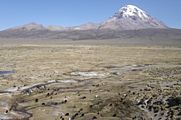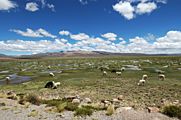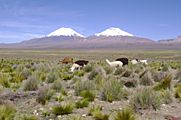Plant cover and water loss
Once the ground is fully covered by vegetation, ET (evapotranspiration) on bright days during summer hardly varies across different vegetation types and averages 4 mm d-1 (a number very similar to lowland ET). Since many days are wet and cold, the seasonal mean for the Alps is only 2.6 mm d-1. The seasonal sum results, in essence, from the duration of the snow free period - a rather surprising finding.
Try to find out why daily ET during the growing season is similar at high and low elevation in mountains of humid zones once vegetation fully covers the ground (consulting the lesson Dynamic mountain climate may help).
Need some help?
Consider the influence of low stature vegetation on canopy temperature, consider the effect of reduced atmospheric pressure...
Want the answer?
Solar radiation heats the ground and small sized plants, so that steep thermal gradients build up between plants and the free atmosphere. These temperature gradients create a very steep water vapour gradient which enhances vapour loss. In addition, low atmospheric pressure reduces the likelihood of molecular collisions and increases the rate of molecular diffusion from wet surfaces (e.g. through the stomatal pores). At 2000 m altitude, the speed of diffusion is increased by roughly 20 %. This was first discovered by H.B. de Saussure on Mt Blanc in 1787.
Local drainage may convert otherwise semi-arid landscapes into fertile and humid pastures at similar elevations (here c. 4200 m).
Remember:
- It is the number of "green" days and not elevation by itself which determines the seasonal water loss of vegetation to the atmosphere.
- Whether these losses can create moisture shortage for plants depends on soils, their depth and stone content in particular.
- Because water is usually in excess of demand in alpine elevations, runoff is very high and so is the risk of erosion.
- Because of this, an intact vegetation (ground) cover is the key to alpine ecosystem stability. No slope can withstand the forces of runoff unless it is secured by closed intact vegetation




